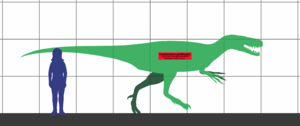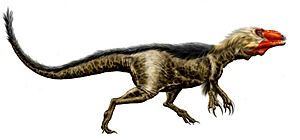Dryptosaurus facts for kids
Quick facts for kids DryptosaurusTemporal range: Upper Cretaceous
|
|
|---|---|
| Scientific classification | |
| Kingdom: | |
| Class: | |
| Superorder: | |
| Order: | |
| Suborder: | |
| Family: |
Dryptosauridae
Marsh, 1890
|
| Genus: |
Dryptosaurus
|
Dryptosaurus was a fascinating meat-eating dinosaur that lived a long, long time ago. Its name means "tearing lizard," which gives you a hint about its sharp claws! This dinosaur was a type of theropod, similar to the famous Tyrannosaurus rex. It roamed eastern North America during the late Cretaceous Period. Scientists first found its fossils in New Jersey. For a while, it was known by a different name, Laelaps.
Dryptosaurus got its name because of its impressive finger claws, which could be as long as 8 inches (21 cm)! We only know about this dinosaur from a partial skeleton, so scientists are still learning more about it.
About Dryptosaurus
Scientists believe Dryptosaurus was about 25 feet (7.5 meters) long. It might have weighed around 1.5 tons, which is like the weight of a small car! These estimates are based on the incomplete bones found from one dinosaur.
Unlike some of its famous relatives like Tyrannosaurus, Dryptosaurus seems to have had fairly long arms. Its hands were also quite large. Each of its fingers ended with a sharp, talon-like claw that was about 8 inches long. Scientists think Dryptosaurus might have used both its strong jaws and its powerful, clawed arms to hunt and catch its prey.
There's a bit of a puzzle about how many fingers Dryptosaurus had. Some scientists believe it had three fingers, while others think it might have had only two working fingers, similar to later tyrannosaurs. Either way, those huge claws would have been very useful for a predator!
The bones found from Dryptosaurus include parts of its skull, jaw, teeth, and many bones from its tail, arms, and legs. These bones help scientists understand how big it was and how it moved. For example, the shape of some foot bones suggests that Dryptosaurus had a special foot structure. This structure helped it run faster, similar to other advanced tyrannosaurs like Albertosaurus and Tyrannosaurus.
Images for kids
-
An outdated historical depiction of Dryptosaurus (center) confronting Elasmosaurus, with two Hadrosaurus in the background. By Edward Drinker Cope, 1869
-
Leaping Laelaps by Charles R. Knight, 1897
See also
 In Spanish: Dryptosaurus aquilunguis para niños
In Spanish: Dryptosaurus aquilunguis para niños








